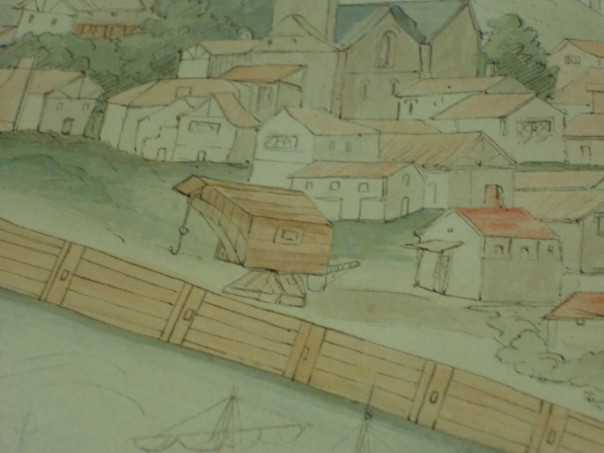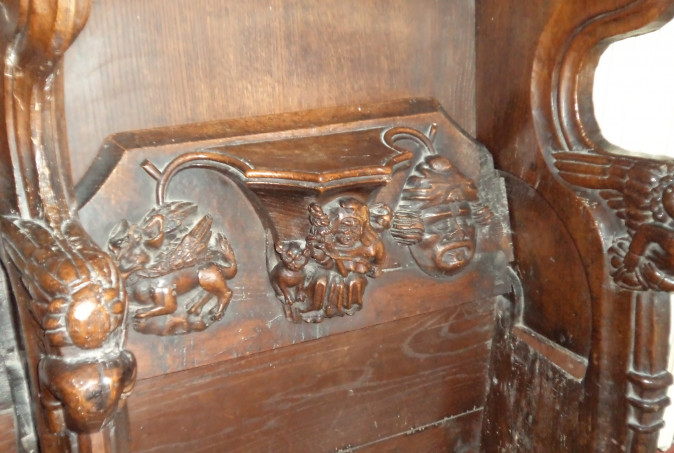This week has been more meetings, as well as teaching, of course, but I did manage an afternoon in Canterbury Cathedral Archives which I’ll come to in a minute as I can link it, albeit tenuously, to yesterday being Valentine’s Day.
However, before I come to that I thought I would bring you the programme of the CKHH ‘Inspirational Kent Women Writers’ day on Saturday 2 March at Augustine House. This day of talks and an exhibition will celebrate the lives and writings of Kent women across the ages. Inspired by Canterbury’s Aphra Behn and in Women’s History Month, as the organisers Drs Claire Bartram and Astrid Stilma explain, we will explore the lives and experiences of Kent women playwrights, novelists, historians and poets from the seventeenth to the twentieth century. The event will include an exhibition of artefacts from the CCCU Library Special Collections presented in collaboration with the International Centre for Victorian Women Writers.

So to the programme, following the welcome at 9.45, the first speaker will be Professor Jackie Eales who will discuss the life of Elizabeth Elstob under the title ‘“One Tongue is Enough for any Woman”: Elizabeth Elstob (1673–1756) and the Fight for Female Education’. Jackie will be followed after a short break by Dr James Metcalf whose subject is Elizabeth Carter, and his title is ‘‘Death’s Refreshing Shade’: Elizabeth Carter, ‘Church-yard Poetry’, and Contemplative Retirement in the Gardens of the Dead’. Before breaking for lunch and a chance to view the exhibition, Michelle Crowther will offer an introduction to the CCCU Library Special Collections on which it is based.
The first of the afternoon sessions is a double bill beginning with Dr David Shaw from his work in Canterbury Cathedral Library on Sarah Dixon. His title is ‘Sarah Dixon’s Poems on several occasions (Canterbury, 1740) and its reception: an examination of the list of subscribers’. David will be followed by Dr Laura Allen on ‘Uncovering the Life of Kent’s Bessie Marchant: A Journey through the Archive’. Bearing in mind the Aphra Behn project connection, it is fitting that the last presentation of the day will be given by Professor Elaine Hobby and her subject for this conference will be ‘Vita Sackville-West’s biography of her Kentish literary predecessor, Aphra Behn (1640–1689)’. This is an exciting programme for this FREE conference, but please do book because space is limited. The booking form can be found at: https://ckhh.org.uk/events/details/inspirational-kent-women-writers
Then the following Saturday at The Beaney, Dr Catriona Cooper will be leading a linked ‘Inspirational Women of Kent Co-creation Workshop’. This too is FREE, and the workshop is a co-creative process where we’ll identify inspiring Kent women, collect information about them and write their biographies. The result will be a brand new interactive digital exhibition, mapping their lives and work, to share their stories and the places they happened.

As Dr Cooper say, starting with Canterbury’s literary daughter, Aphra Behn, we want to share other women’s stories. Consequently, do you want to help spread the word about Kent’s Inspiring Women? Participants do not need digital skills, and support and refreshments will be provided. So if this is for you, please do book at: https://ckhh.org.uk/events/details/inspirational-women-of-kent-co-creation-workshop
Moving on to Saturday 23 March and down to Dover, our ‘Migrants, Merchants and Mariners in the Kentish Cinque Ports, c.1400–c.1600’study day at Dover Museum, in conjunction with the Maison Dieu, will be kindly hosted by Jon Iveson and Martin Crowther. This, too, is a FREE event starting at 10am and finishing at 4pm comprising talks and our pop-up exhibition, space is limited so please do book: https://ckhh.org.uk/events/details/migrants-merchants-and-mariners-in-the-kentish-cinque-ports-1400-1600
The schedule in outline: 10am welcome, followed by Dr Craig Lambert on an Introduction to the Kent’s Maritime Communities, c.1400 to c.1600 project; me on Kent as a ‘Gateway County’. After a break, our final talk for the morning will be The Maison Dieu and the Sea by Kieron Hoyle. Lunch follows between noon and 1pm and there are several nearby refreshment outlets because Dover Museum is located in the Market Square, also useful for those seeking coffee etc during the morning and afternoon breaks. The afternoon opens with a talk by Jason Mazzocchi on The Free Fishermen and Dredgermen of Faversham, to be followed by Dr Robert Blackmore speaking on Maritime Trade and Kent’s Ports. We’ll then have a break before Dr Lambert again on Kent’s Ships and Mariners followed by our concluding Roundtable session. Moreover, we’ll be around all day and will be happy to discuss the pop-up exhibition with members of the audience.

Now why I was in the Cathedral Archives yesterday and what did I find. The answer to both is Lenham because also in March I’ll be giving a talk to Lenham Local History Society. Such activities are also undertaken by other members of CKHH including Drs John Bulaitis, Diane Heath and Martin Watts, but I think I may be the first in terms of Lenham. Now I shall be speaking on ‘Going to church in medieval Kent’ and I wanted to have a look at a few wills from the pre-Reformation community there. Lenham is somewhere I have explored for the early 1540s but that will form the postscript for the presentation. For today I wanted the medieval Catholic church and its parishioners.
However, the beauty of working with wills is that you never know what you are going to find, and even though these are not quite the most extensive examples I have ever seen, they are good and illustrate some interesting features, as well as offering insights into living conditions in the early 16th century. The reason I’m linking them to Valentine’s Day is that they concern the wives of these two testators and how these dying men wished to provide for hopefully the women that they loved or as is sometimes described as being their partner in a ‘companionate marriage’. What I’m talking about is a maintenance agreement for the benefit of the widow. Thus in 1515, Peter Adam of Lenham bequeathed to his son Harry the family home, gardens and his other lands on condition that Harry ‘suffered his mother to have dwelling in the south end of the messuage’. She was also to have access to ‘fire and fleet’ [hearth and home] in the hall, and one can imagine her sitting by it on a winter’s evening. Furthermore, she was to have ‘free going and coming into the kitchen at all times to her necessary to bake and brew’, bread and presumably ale in this case rather than beer, being the staples of her life, although she would have been able to supplement them using money from the annuity Harry was also to provide.
A couple of years later in 1518, Hugh Badnor similarly included a maintenance agreement in his will. In this case Agnes his wife seems to have had access to far less of the house and may, indeed, have spent much of her remaining life in the kitchen with its associated rooms. She was also to receive two gardens ‘lying to the street’ where presumably she was able to grow some of her food. Hugh intended that she should have access to the well at his house, but what is something I don’t remember seeing before is the clause that ‘he that dwelleth in the hall [the main room of the house] shall have liberty to bake their bread in the oven in the kitchen’. Whether that lead to friction among those in Hugh’s house we will never know but it makes for a fascinating scenario!

Nevertheless, what it does highlight is the importance of certain rooms such as the hall and kitchen, although in some other cases the parlour is mentioned too. Equally significant is access to the fire – as somewhere to sit and for women a place they can sit and spin, thereby being productive, rather than spinning even in the 21st century it might still be knitting. Then the well for water – for cooking primarily perhaps, whereas for laundry I have seen a reference of free access to the pond (towns with rivers often had communal laundry places). Finally, access to the oven and/or the open fire in the kitchen, for the kitchen was (and in many farmhouses still is) the place where those living there congregate to cook, possibly to eat and to relax. So just a couple of snippets but hopefully of interest as an opening into the past.
 Centre for Kent History and Heritage
Centre for Kent History and Heritage Sheila Sweetinburgh
Sheila Sweetinburgh 1490
1490

